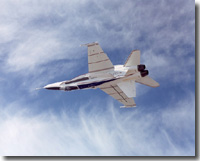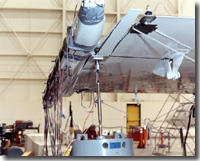ACTIVE AEROELASTIC WING COMPLETES FIRST PHASE OF FLIGHT TESTS
May 1, 2003
Release: 03-25
Printer Friendly Version

With a final sonic boom reverberating over the desert north of Edwards Air Force Base, a NASA research aircraft has completed the first phase of the Active Aeroelastic Wing (AAW) flight research program.
NASA research pilot Richard Ewers flew the final two test points during the brief 35-minute flight in mid-April from NASA’s Dryden Flight Research Center at Edwards. In all, 50 test missions were flown by two project pilots in the modified, highly instrumented F/A-18A over the course of five months since the first flight last November.
The Active Aeroelastic Wing project seeks to determine the advantages of twisting flexible wings for primary maneuvering roll control at transonic and supersonic speeds. From flight test and simulation data, the program will develop structural modeling techniques and tools to help design lighter, more flexible high aspect-ratio wings for future high-performance aircraft. Greater freedom in wing design will enable more economical operation or greater payload capability.
Although similar in concept to the “wing warping” control system pioneered by the Wright brothers almost a century ago, AAW employs conventional control surfaces such as ailerons and leading-edge flaps to aerodynamically induce the twist, rather than mechanically twisting the wingtips as on the Wright Flyer.
“The first phase of flight tests focused on what we call parameter identification – essentially evaluating control surface effectiveness at rolling the aircraft or twisting the wing,” said Dryden’s AAW project manager Larry Myers. “We flew test points at altitudes ranging from 5,000 to 25,000 feet, and at speeds from Mach 0.8 to 1.3.”

Prior to the beginning of flight tests, the F/A-18’s wings were modified to increase their flexibility, equivalent to the those on prototype and pre-production F-18s. Those early wings were deemed to be too flexible to meet Navy performance specifications at transonic and supersonic speeds due to a phenomenon known as aileron reversal. Aileron reversal occurs when high dynamic pressures cause a too-flexible wing to twist when the ailerons are moved up or down, severely reducing the aircraft’s roll rate and maneuvering capability. The wing structure on production F/A-18s was then stiffened to help it meet the Navy’s specifications.
“What we are trying to do in AAW is take what is traditionally a negative-too much wing flexibility – and turn it into a positive,” Myers added.
Over the next two months, AAW engineers at NASA Dryden and at Boeing’s Phantom Works division will analyze the extensive data recorded during the first phase of flight tests. Armed with that information, the Phantom works engineers will then write the control law software for the AAW research flight control computer. After an extensive period for verification, validation, integration and checkout of the new software with the aircraft’s control systems, the second phase of AAW flight tests should get under way in early 2004.
While new flight control software is being developed, the AAW research aircraft will undergo inspection, maintenance and installation of additional flight test instrumentation. It will also be flown to the Midwest for display at several air shows during the summer in connection with Centennial of Flight activities. Those shows include:
- The Dayton International Air Show at Dayton, Ohio, July 17 – 20;
- The Grissom Air Force Base air show at Kokomo, Ind., July 26-27;
- The Experimental Aircraft Association’s AirVenture 2003 at Oshkosh, Wis., July 29 – Aug. 4.
AAW is jointly funded and managed by the Air Force Research Laboratory’s Air Vehicles Directorate and NASA Dryden, with Boeing’s Phantom Works division in St. Louis, Mo., the prime contractor for aircraft modifications and software development.
-nasa-
Note to Editors: Interviews with NASA Dryden AAW project manager Larry Myers or other project personnel can be arranged by calling (661) 276-2665. Still photos and video footage are available to support this release. Photos are available on the NASA Dryden Flight Research Center internet website at: /centers/dfrc/Gallery/Photo/index.html For photo prints or video dubs, please call (661) 276-2665 . NASA Dryden news releases are also available on the Internet at: /centers/dfrc/Newsroom/NewsReleases/index.html
























